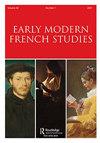模拟卡尔文:反对自封为Spiritalz的幽灵和愤怒的放荡不羁教派(1545)
IF 0.2
3区 历史学
Q2 HISTORY
引用次数: 0
摘要
本文考察了加尔文在1545年所著的《幻想与自由》中的一些模仿实例。加尔文谴责精神上的自由主义者,这是一个最近从低地国家传播到法国北部的不知名的反律法教派,由于担心其他人可能会将他们的神学的某些方面与他的混淆,他的谴责变得更加激烈。模仿对手的皮卡德方言是将他们的声音与自己的声音区分开来的几种方法之一。尽管加尔文在其他地方展示了自己犀利幽默的能力(例如,在《遗像》中),但在他的作品中,言语模仿的例子很少,具有一种滑稽的品质,更容易与拉伯雷(在《利穆赞先生》中出现的那一节)或莫里埃尔(在《波西奥涅克先生》中出现的那一节)联系起来。在约阿希姆·杜·贝雷(Joachim Du Bellay)的《法兰西语言的辩护与阐释》(defense et illustration de la language francoise, 1549)出版的四年前,异教的声音与地区的声音的混合提出了关于语言和民族的更广泛的问题。本文章由计算机程序翻译,如有差异,请以英文原文为准。
Calvin the mimic: Contre la secte phantastique et furieuse des libertins, qui se nomment spirituelz (1545)
This essay examines some instances of mimicry in Jean Calvin’s Contre la secte phantastique et furieuse des libertins, qui se nomment spirituelz (1545). Calvin’s denunciation of the spiritual libertines, an obscure antinomian sect which had recently spread from the Low Countries to northern France, is made all the more vehement by a fear that others might confuse some aspects of their theology with his. Mimicry of his opponents’ Picard dialect is one way among several of marking off their voices from his own. Although Calvin shows himself elsewhere capable of trenchant humour (for example, in the Traité des reliques) examples of speech-parody are rare in his work, possessing a farcical quality more readily associated with Rabelais (the episode of the ‘écolier Limousin’) or Molière (Nérine in Monsieur de Pourceaugnac). The blending of heretical voices with regional ones raises broader questions of language and nation, just four years before the publication of Joachim Du Bellay’s Deffence et illustration de la langue françoyse (1549).
求助全文
通过发布文献求助,成功后即可免费获取论文全文。
去求助
来源期刊

Early Modern French Studies
Multiple-
CiteScore
0.10
自引率
0.00%
发文量
14
期刊介绍:
Early Modern French Studies (formerly Seventeenth-Century French Studies) publishes high-quality, peer-reviewed, original articles in English and French on a broad range of literary, cultural, methodological, and theoretical topics relating to the study of early modern France. The journal has expanded its historical scope and now covers work on the sixteenth, seventeenth, and eighteenth centuries. Within this period of French literary and cultural history, the journal particularly welcomes work that relates to the term ''early modern'', as well as work that interrogates it. It continues to publish special issues devoted to particular topics (such as the highly successful 2014 special issue on the cultural history of fans) as well as individual submissions.
 求助内容:
求助内容: 应助结果提醒方式:
应助结果提醒方式:


